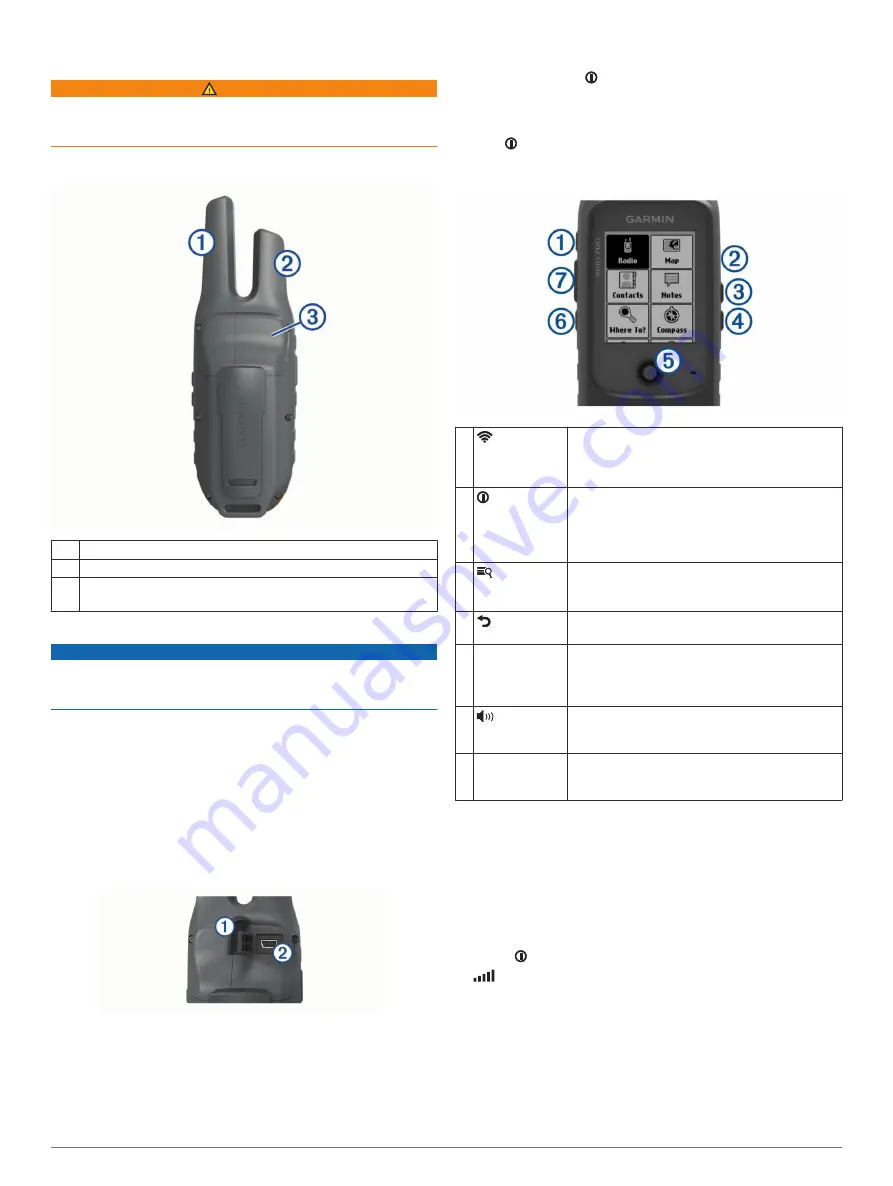
Introduction
WARNING
See the
Important Safety and Product Information
guide in the
product box for product warnings and other important
information.
Device Overview
À
GMRS antenna
Á
GPS antenna
Â
Mini-USB port (under weather cap)
2.5 mm headset jack (under weather cap)
Charging the Battery
NOTICE
To prevent corrosion, thoroughly dry the USB port, the weather
cap, and the surrounding area before charging or connecting to
a computer.
You must charge the device fully before using it for the first time.
Before you can connect the straight connector of the USB cable
to your device, you may need to remove optional mount
accessories.
NOTE:
The device does not charge when outside the approved
temperature range (
).
You can charge the battery using a USB port on your computer
if necessary, but using the included AC adapter is the fastest
way to charge the device.
1
Pull up the weather cap
À
from the mini-USB port
Á
.
2
Plug the small end of the USB cable into the mini-USB port.
3
Plug the large end of the USB cable into an AC adapter or a
computer USB port.
4
If necessary, plug the AC adapter into a standard wall outlet.
When you connect the device to a power source, the device
turns on.
5
Charge the battery completely.
TIP:
You can hold for two seconds to view the charge level
and place the device into power saving mode.
Turning On the Device
Hold .
Device Operation
À
(Call key)
Press to transmit an attention tone on the current
channel.
Hold to send an emergency alert (
).
Á
(Power key)
Press to adjust the backlight and check battery
level.
Hold to turn the device on or off.
While charging, hold to put the device in power
saving mode.
Â
(Menu/zoom
key)
Press to open the menu for a page or item.
Press twice to return to the main menu.
Hold to adjust the zoom level of the map.
Ã
(Back key)
Press to return to the previous item or menu.
Ä
Thumb Stick
Use to highlight a menu item, adjust a slider, and
control the map cursor.
Press to select an item.
Hold to mark a waypoint (
).
Å
(Volume/
squelch key)
Press to adjust the volume and squelch levels.
Æ
PTT
(Push-to-talk
key)
Hold to transmit on the current radio channel
(
).
Acquiring Satellite Signals
It may take 30 to 60 seconds to acquire satellite signals.
1
Go outdoors to an open area.
2
If necessary, turn on the device.
3
Wait while the device searches for satellites.
A question mark flashes while the device determines your
location.
4
Select to open the status page.
shows the GPS/GLONASS signal strength.
When the bars are full, the device has acquired satellite signals.
Radio
In the United States and Canada, this device uses General
Mobile Radio Service (GMRS) for two-way communication with
other compatible radio devices.
In Australia, this device uses UHF Citizen Band Radio Service
(UHF CBRS), and in New Zealand, this device uses UHF
Introduction
1




















